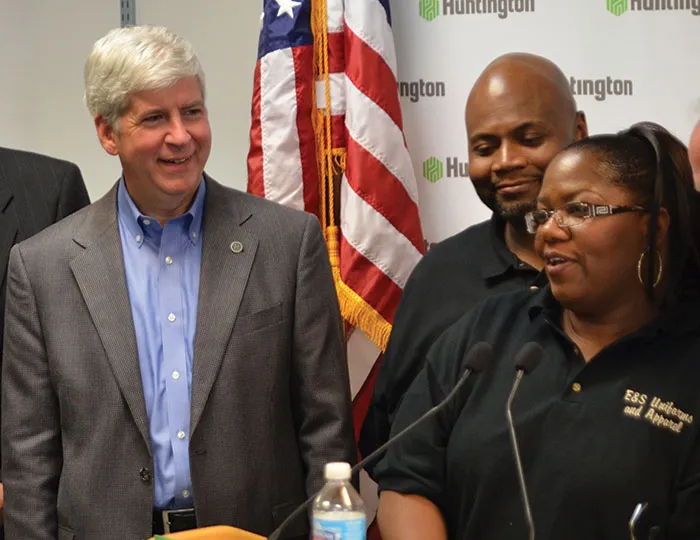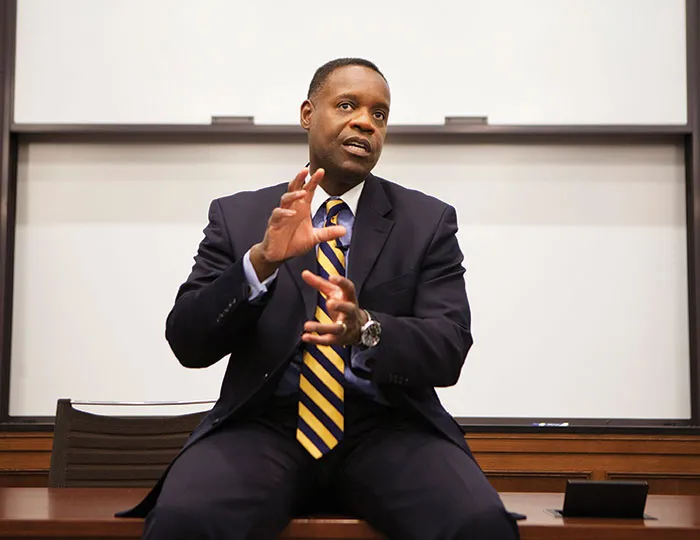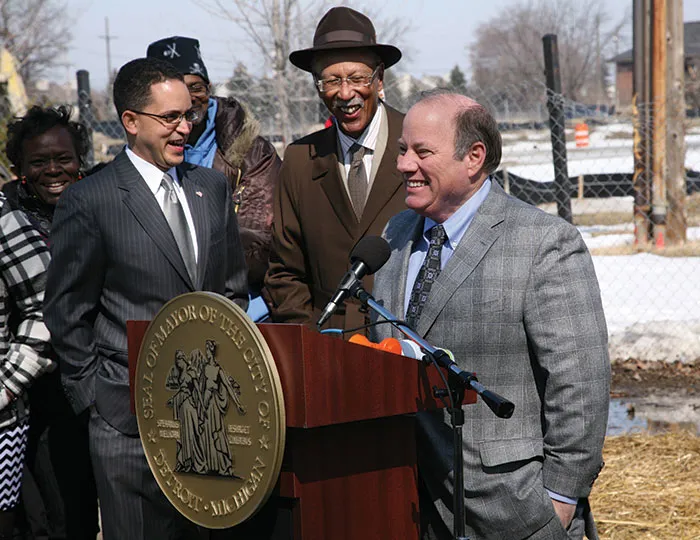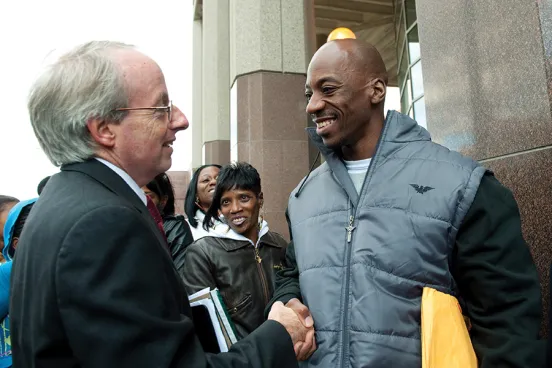The three men now aiming to lead Detroit out of history’s largest municipal bankruptcy have made no secret of their ambitious plans for the beleaguered city.
For Republican Gov. Rick Snyder, ’82, the plan is to continue supporting Kevyn Orr, ’83, whom the governor selected as emergency manager using the sometimes controversial new law; to work with the Legislature to provide $350 million over 20 years for Detroit; and to help ensure improved and essential city services for residents.
For Emergency Manager Orr, the focus is on finalizing the Chapter 9 bankruptcy by the time the anticipated 18-month timeframe of his appointment ends in late September. He also hopes to get approval for his Plan of Adjustment, which calls for pennies on the dollar to bond holders, as well as deep cuts to pension payments and health care to retirees in order to restructure $18 billion worth of long-term debt.
For Democratic Mayor Mike Duggan, ’83, the goals are to ramp up city services, including bus operations, streetlight installation, and blight removal, and to entice residents back to the city.
The three leaders—who once crossed paths in their overlapping years at Michigan Law—today say they have congenial, professional, and productive relationships. They have frequent meetings, sometimes over dinner. Duggan and Orr share office space, and their respective top staff members work closely together. In Duggan’s first few months as mayor, he assumed control of most of the city’s departments, with Orr retaining sole power over the police department and the city finances.
What remains to be seen is how the powerful trio’s work will coalesce to define the future not only for the city of some 685,000, but for the surrounding region and, in some ways, the state. Will Detroit bounce back? Will residents experience a revived sense of pride in their city? Will outsiders view Detroit as a cautionary tale or an inspiring turnaround story? Much of that will be determined by the actions of Snyder, Orr, and Duggan.

Rick Snyder
Snyder and the Emergency Manager Law
Back in January 2011, Snyder took office with no previous elected experience but a business resume that included CEO of Gateway Computers and founder of two venture capital funds. He was promptly named Newsmaker of the Year by Crain’s Detroit Business, and his early initiatives were aimed at private sector tax cuts and job creation. He talked about how important it was to the entire state for Detroit to be strong. Then Michigan’s Public Act 4 became effective in March 2011.
The new law, a reformed version of the one Democratic Gov. Jennifer Granholm had used in nine communities, provided for emergency managers to be appointed in municipalities and school districts that were in financial distress. Snyder and his team took the first steps on that route in Detroit in December 2011 with the state treasurer ordering a preliminary financial review of the city. Later that month, the treasurer declared that the city was in “probable financial distress” and recommended to Snyder that he authorize a financial review team, per Public Act 4’s prescription.
Snyder did, the team went in, and on March 21, 2012, he declared the city to be in a severe financial emergency. “This week, the city is projected to have $42.4 million in the bank,” a Detroit Free Press article read at the time. “Detroit needs roughly $60 million to operate each month. By the end of the fiscal year on June 30, the city is projected to have a $46.8 million negative balance in the general fund.”
Following an unsuccessful court challenge by the Detroit City Council, a consent agreement was signed by Snyder, then-Detroit Mayor Dave Bing, and the city council; an oversight board began to meet, seeking ways Detroit could meet its financial obligations for services, debt, and pensions.
But later that year, Public Act 4, and the governor’s powers stemming from it, were suspended when the question to overturn it was placed on the November ballot. Additionally, the city hadn’t made substantial progress on the terms of the consent agreement and hadn’t met agreed-upon milestone markers. Voters did scrap Public Act 4, but the lame-duck Legislature passed a new version of the law. Snyder signed it.
A January 2013 audit revealed a $327 million accumulated deficit as of the previous June, and in February, a state review team reported that Detroit leaders had “no satisfactory plan” to resolve its financial emergency. Snyder recommended Orr—then a partner at Jones Day who was living with his family in the Washington, D.C., area—to be emergency manager, and the state’s Emergency Loan Board approved the selection.
Orr’s appointment made international headlines. “Detroit is being watched closely for clues on how a heavily indebted municipality can regain its financial footing and longer-term viability,” the London Financial Times wrote.
Immediately the world wondered how long it would be before the city filed for bankruptcy. In his first public statements after his appointment, Orr said he hoped to avoid Chapter 9. But he warned that if the city’s creditors were not willing to negotiate and forgive some of the debt, he was willing to do it.

Kevyn Orr
Orr: “Detroit Will be a Success Story”
Arriving for his tenure as the emergency manager, Orr returned to a city he had once been familiar with in his youth. A native of Fort Lauderdale, Florida, Orr frequently visited his cousins on Detroit’s east side.
When it came time to choose a college, Orr was interested in a large public institution. He was focused on the University of Virginia, Berkeley, and U-M. He decided to nix Virginia—”I wanted to get out of the South”—and Berkeley, which was too far away for Orr’s mother to support his matriculation there. “Michigan has such a great history,” Orr says. “It had Students for a Democratic Society [a leftist 1960s activist group], the Peace Corps with John Kennedy, the Black Action Movement, the Black Panthers,” Orr says. “Plus, my best friend growing up, TJ Redding, was going there. So there were a whole host of reasons why Michigan just made sense.”
Orr graduated in three and a half years, spending some social time in Detroit on the weekends, and then moved to Colorado. A self-described “ski bum” for a few months, a passion that remains when he can find the time, he returned to Ann Arbor in May 1980 and enrolled in the Law School as a summer starter.
“I wanted to be a civil rights lawyer. Law school was really going to be a road for me to achieve social equity, to right the wrongs of the past,” he remembers with a grin. “When I went to Michigan, I was sort of a budding socialist. I was going to stick it in the eye of the man. Now I am the man.”
Through his classes at Michigan Law, he found “a way of thinking, a rigor, a balance” that he considers the backbone of his entire legal career and continues to define his work as Detroit’s emergency manager. “You don’t even realize it,” he says, “but after law school, you see things differently.”
Following law school, Orr joined Arky, Freed, Stearns, Watson and Greer in Miami, where he rose from litigator to shareholder. He later worked at the Federal Deposit Insurance Corporation and then the Resolution Trust Corporation, where he became the assistant general counsel for complex litigation and bankruptcy. His duties included serving as the agency’s chief lawyer responsible for the Whitewater investigation. He then worked for the Department of Justice as deputy director of the Executive Office for United States Trustees, and later was the director of the United States Trustees Program. In 2001, Orr joined Jones Day, where his responsibilities included counseling and representing Chrysler LLC with regard to its bankruptcy, in addition to many other high-dollar and high-profile cases.
He had been chosen to open the firm’s new Miami office and to receive what he describes as a “significant percentage” on a winning case; he left both the opportunity and the money behind when he accepted the emergency manager position. “When I was first approached with the job, my response was not only ‘no,’ it was ‘hell no.'” But he reconsidered, ultimately deciding that it was an opportunity to give back.
As part of his preparation for the new job, Orr compiled a research binder with notes about the city, reports about the state and its finances, and news accounts of its public figures. On his desk, he keeps the book Origins of the Urban Crisis: Race and Inequality in Postwar Detroit by Thomas Sugrue. Looking back to the time he arrived at his 11th-floor office in the Detroit mayor’s suite, Orr says he thought knew much of what he needed to about Detroit. “I’ve inhabited this world of restructuring and bankruptcy for almost 30 years,” he says. But nothing could fully prepare him for the scope of the city’s problems—or for the tensions with current and former public sector employees, many of whom have protested the decision-making authority given to an unelected official and the proposed cuts to city retirees’ pensions.
For Catherine Kelly, the publisher of the Michigan Citizen, one of Detroit’s leading African American newspapers, there is another significant difference between Orr as emergency manager for the city’s Chapter 9 filing and his previous roles in corporate Chapter 11 cases. Her unease is that he, as an appointee and not an elected representative, has the ability to make near-unilateral decisions to restructure the city and disperse assets.
“The concern is that the emergency manager-led bankruptcy is a complete affront to the democratic process and relies on the benevolence, vision, and ability of one unelected person,” she says. “The wrong move or mistake could cause irreparable harm to an already-hurting city.”
Orr says he is sympathetic to the plight of the city and its residents, and that he has tried to minimize the impact on individuals. Still, he says, drastic changes are necessary in the city, thanks in particular to massive population declines and money mismanagement.
In a recent talk at Michigan Law, Orr cited one of the more striking elements of poor financial planning in Detroit: “Between 2005 and 2012, the city borrowed $2.25 billion on a $1 billion revenue stream.” If deals weren’t struck with the city’s creditors, if pensions weren’t cut, “the city would die. There is no conceivable way this debt was ever going to be paid off,” he said.
That talk marked one of the first times he publicly discussed the mismanagement of the city’s pension funds. For instance: The General Retirement System (GRS) pension fund (the one for city employees and retirees outside of the police and fire departments) has 30 percent of its investments in private equity, real estate, or areas otherwise not receiving any professional advice. “Of that 30 percent of investments that they’ve made, they’ve made investments in defunct hotels, they’ve subordinated their interest to 22 tranches of debt and various other real estate investments—hell, we own part of a private jet in the GRS pension fund,” Orr said during his visit to the Law School. And of the $1.4 billion that the city borrowed between 2005 and 2006 to fund pension payments, he said, “we can’t find $700 million of it. Can’t find it.”
That, he says, is unacceptable, and he wants to help the city bounce back from the mismanagement of the past. He says the city can and will rebound, in spite of myriad challenges. “Detroit will be a success story. Believe it,” he says.
While Orr addresses the financial woes, the city’s more systemic problems are something Mayor Mike Duggan has targeted during his first months in office.

Mike Duggan
Duggan: Building Relationships
Duggan’s election win had been viewed as improbable by many observers, perhaps those who did not know him very well. He first won a write-in campaign in the August 2013 primary, then out-campaigned and out-fundraised his opponent, Wayne County Sheriff Benny Napoleon. In doing so, Duggan became the city’s first white mayor in 40 years.
Elected in November 2013, the former Detroit Medical Center CEO and Wayne County prosecutor has created a noteworthy cabinet and in his first months has publicly courted the city council in a way few remember a mayor ever doing.
Duggan, a Democrat some have already touted for governor, made no secret of his feelings about the city essentially being run by not only an emergency manager, but one appointed by a Republican governor. He didn’t like it.
But he promised he would work with Orr, and even before Duggan’s January 1 inauguration, the two were meeting weekly for dinner and in between for other discussions with each other and staff members.
As the weeks went on, the two developed what staff have described as an intense but productive working relationship. Melvin “Butch” Hollowell, Duggan’s general counsel, says there are weekly evaluations of everyone in the mayor’s cabinet done by assessing what progress they’ve made on tasks between staff meetings.
“Make no mistake about it, it is not for the fainthearted,” Hollowell says of working in city hall these days, where Duggan and Orr share the mayor’s suite. “It’s intense on the 11th floor.”
Some of that, politicos say, is Duggan’s powerful drive. But the mayor also set high expectations for himself, and he did so very publicly. Days after he took office, he set an urgent timetable for himself, asking city residents to give him six months to show that blight, street light functionality, and bus services could be improved.
“I say to you one thing: Just give us six months. Give us six months to prove that we can turn things around. Just push the pause button and don’t leave that house yet,” Duggan said. “Give us six months before you walk away from the value of that house. Give us six months and let us prove to you what we can do.”
He came back harder in his State of the City speech in February, announcing the city would work to set up D-Insurance, a self-administered plan to provide affordable rates for city residents. (Duggan said his own rates doubled when he moved into Detroit.) He promised new ambulances, more EMTs, better maintenance of the city’s parks, and the future launch of an incubator to help entrepreneurs access capital, mentors, and work sites.
“The change has started and the change in Detroit is real,” he said. That change includes funding for the removal of blighted houses: “If you drive through most of the neighborhoods today, you wouldn’t know there was a national recovery,” Duggan said in the address. “People in this community see parts of the country doing well and even parts of the city doing well and others are left behind.”
In the complex governance structure of the city, it is a huge benefit that Duggan is known as a strong relationship-builder. “The relationship between Duggan and Snyder seems good, but it’s in the early days,” says Nancy Kaffer, columnist at the Detroit Free Press. “Duggan and Orr have a power-sharing agreement that bars Duggan from doing anything to undermine the bankruptcy, so it seems unlikely that Duggan would become publicly antagonistic to Snyder.”
Duggan may have 350 million other reasons to be on board with Snyder’s plans for the city.
What’s Next: The Grand Bargain
In his budget presentation to the Michigan Legislature’s Joint Appropriations Committee in February, Snyder announced his intent to seek $350 million over 20 years for the city. Indeed, those funds are part of the “grand bargain” included in Orr’s Plan of Adjustment. Along with $100 million from the Detroit Institute of Arts and $365 million pledged from foundations, the deal would make money available for the underfunded city pensions on the agreement that DIA artwork would not be sold to pay for the liabilities.
Snyder has pitched the idea to legislators, media, and the public. During the spring, he will need to get it passed as part of the state budget so the funds are available to the city. In addition, bankruptcy Judge Steven Rhodes, ’73, will need to approve the Plan of Adjustment and Disclosure Statement that Orr made public in February and creditors planned to vote on this spring in advance of the July trial. City attorneys have promised amendments to the preliminary plan, which outlines how the city will shed its $18 billion debt, including reducing pension and creditor payments, restructuring operations, and improving how taxes are collected.
As of this writing, the grand bargain is part of the overall Chapter 9 strategy. What remains to be seen is if Snyder can make it happen for the city, and what it will mean for his re-election campaign in the fall. “Detroit is a great and proud city. I’m convinced the necessary actions we have taken will allow it to thrive and complete its turnaround for the benefit of all Detroiters and Michiganders,” he says.
Snyder, Orr, and Duggan all know the importance of moving the city past the bankruptcy phase and on to the revitalization phase. The stakes are high for all of them; as Orr said at a recent talk to Michigan Law students: “I will be the greatest flameout in contemporary history if I muff it.”
Says Duggan: “Detroiters need change, and they deserve change now. My administration has developed the vision and strategies to turn things around in our City. We are improving city services. We are rebuilding neighborhoods. And we are creating job opportunities. When the City emerges from bankruptcy, and Kevyn Orr is gone, we will have already created a great foundation that we can continue to build upon.
As part of the Detroit Journalism Cooperative, Sandra Svoboda runs the www.nextchapterdetroit.com for WDETFM, Detroit’s Public Radio station. She is a veteran Michigan journalist, having formerly worked for the Associated Press and The Metro Times in Detroit and The (Toledo) Blade.







